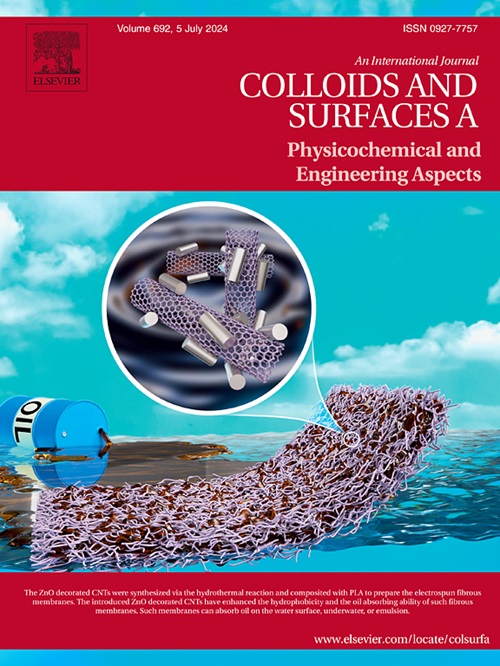任意润湿性多孔介质中不溶到混溶的转变及其对三相位移的影响:三维孔隙网络结果与基本理论的比较
IF 4.9
2区 化学
Q2 CHEMISTRY, PHYSICAL
Colloids and Surfaces A: Physicochemical and Engineering Aspects
Pub Date : 2024-10-29
DOI:10.1016/j.colsurfa.2024.135673
引用次数: 0
摘要
之前的一篇论文通过最简单的毛细管束(CB)模型,使用 "基于过程 "的模型,研究了在任意润湿性分布的系统中,从不相溶到相溶的转变理论及其对三相位移的影响。不出所料,毛细管束模型无法捕捉到许多现实现象,如相捕获、薄膜和层流、拓扑效应等。然而,人们认识到,该模型应能显示真实三维连通网络中三相位移的某些预期定性趋势。本论文扩展了先前的工作,显示了将多孔介质模型改为三维连通晶格孔隙网络模型(PNM)以捕捉相捕获和岩石连通性的后果。为了与 CB 模型进行清晰的比较,最初的工作使用了简单的三维规则立方键格。三维网络的两个重要特征是:(i) 位移相的可达性;(ii) 防卫相的捕获/逃逸。在三维晶格网络中,根据入侵相位可达性和防御相位逃逸的概率定义了三种逃逸情况。研究了不同配位数(z = 6 和 4)的网络,以模拟不同的岩石连通性,并研究了所应用的规则如何以及以何种方式导致三相饱和路径、三相孔隙占位和相捕获的具体变化。同样,本文的重点是预测系统从不相溶(IFT σgo ∼ "大")到相溶(σgo → 0)情况下所有这些量的变化。针对 CB 和 PNM 模型,介绍了不同混溶条件下不同相侵入的饱和路径和孔隙占据序列。研究发现,在网络连接良好的情况下,考虑放宽防御相和置换相的规则,结果与 CB 模型十分相似。此外,应用受限的捕获/逃逸规则和连接较少的网络意味着偏离 CB 模型,但在所有情况下,不混溶到混溶转变的基本物理过程和三相位移的中心物理参数与 CB 模型观察到的结果相同。本文章由计算机程序翻译,如有差异,请以英文原文为准。
The immiscible to miscible transition and its consequences for 3-phase displacements in porous media of arbitrary wettability: Comparison of 3D pore network results with basic theory
The theory of the immiscible to miscible transition and its consequences for 3-phase displacements in a system of arbitrary wettability distribution has been studied in a previous paper using a “process based” model through the simplest case possible; a capillary bundle (CB) model. As expected, the CB model was not able to capture many realistic phenomena such as phase trapping, film and layer-flow, topological effects etc. However, it was recognized that it should be able to indicate certain expected qualitative trends in 3-phase displacements in real 3D connected networks.
The current paper extends that earlier work by showing the consequences of changing the model of the porous medium to a 3D connected lattice pore network model (PNM) to capture phase trapping and rock connectivity. Initially a simple 3D regular cubic bond lattice is used for this initial work to make a clear comparison with the CB model. Two important characteristics of 3D network refer to (i) displacement phase accessibility, and (ii) defending phase trapping/escape. Three trapping/escape cases based on the probability of invading phase accessibility and defending phase escape have been defined in the 3D lattice network. Networks with different coordination numbers (z = 6 and 4) were studied in order to mimic different rock connectivity and study how and in which way the applied rules result in specific changes in 3-phase saturation paths, 3-phase pore occupancies and phase trapping. Again the focus is on the changes which are predicted to occur in all these quantities as the system moves from an immiscible (IFT σgo ∼ “large”) to a miscible (σgo → 0) case.
In this paper, a weakly oil-wet (WOW) wettability distribution is considered and various phase invasions (gas, water, and oil) in the corresponding 2-phase systems are investigated. Both saturation paths and pore occupancy sequences of different phase invasions under different miscibility conditions are presented for both the CB and PNM models. It is found that having a well-connected network and considering a relaxed rule on defending and displacing phases, the results are quite similar to that of the CB model. Also, applying restricted trapping/escaping rules and less connected network mean deviation from the CB model, but the underlying physics of the immiscible to miscible transitions and the central physical parameter of 3-phase displacements in all cases are the same as those observed for the CB model.
求助全文
通过发布文献求助,成功后即可免费获取论文全文。
去求助
来源期刊
CiteScore
8.70
自引率
9.60%
发文量
2421
审稿时长
56 days
期刊介绍:
Colloids and Surfaces A: Physicochemical and Engineering Aspects is an international journal devoted to the science underlying applications of colloids and interfacial phenomena.
The journal aims at publishing high quality research papers featuring new materials or new insights into the role of colloid and interface science in (for example) food, energy, minerals processing, pharmaceuticals or the environment.

 求助内容:
求助内容: 应助结果提醒方式:
应助结果提醒方式:


